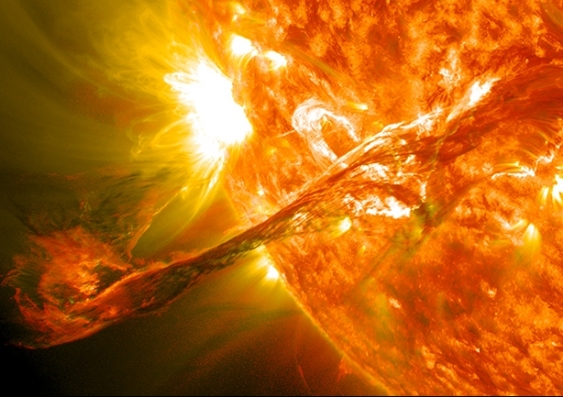创新背景
年轻的恒星——就像年轻的人类一样——容易发脾气。但是恒星耀斑可以烧毁它们周围的一切,包括附近开始形成的行星的大气层。
了解年轻恒星喷发的频率可以帮助科学家了解到哪里去寻找适宜居住的行星。但到目前为止,寻找这些耀斑还需要通过肉眼观察数千次恒星亮度变化的测量数据,也就是所谓的“光曲线”。
创新过程
一个国际科学家团队已经使用机器学习使搜索更快更有效。科学家们教会了一个神经网络——一种人工智能——来探测恒星耀斑的发光模式。

恒星表面明亮的闪光是恒星耀斑:由恒星磁能释放引起的强大辐射爆发。强烈的耀斑之后可以伴随着恒星物质的喷射,如上图所示。
在神经网络的帮助下,研究人员能够在数千颗年轻恒星中发现23000多个耀斑。发现恒星耀斑——它对附近行星正在发展的大气层可能是致命的——可以帮助科学家寻找宜居行星。
年轻的恒星指的是只有100万到8亿年的年龄,在这一点上,任何靠近恒星的行星都还在形成。这是一个特别脆弱的时期,来自恒星的耀斑很容易蒸发任何收集到的水或大气。
建立一个神经网络
NASA的TESS望远镜搭载在一颗自2018年以来一直绕地球运行的卫星上,是专门为搜索系外行星而设计的。TESS的图像显示了来自遥远恒星的耀斑,但传统算法很难从恒星活动的背景噪声中分辨出耀斑的形状。

但神经网络特别擅长使用寻找模式——就像谷歌的人工智能从网络图像中挑选猫一样——天文学家已经越来越多地开始利用它们来对天文数据进行分类。
科学家们团队合作,将一组已识别的耀斑和非耀斑集合在一起,以训练神经网络。研究人员表示,神经网络被证明非常擅长发现小的耀斑,而这些耀斑实际上很难用其他方法找到。

研究小组在神经网络的帮助下,在数千颗年轻恒星上发现了超过23,000个耀斑。
一旦研究人员对神经网络的性能感到满意,他们就将其应用于一整套数据:超过3200颗恒星。
创新关键点
一个国际科学家团队已经使用机器学习使搜索更快更有效。科学家们教会了一个神经网络——一种人工智能——来探测恒星耀斑的发光模式。
创新价值
这一新发现为人工智能在天文学上的应用提供了一个新的基准,也更好地理解了年轻恒星及其行星的演化。
研究结果有助于科学家了解在不同类型的恒星周围存在宜居行星的几率,以及大气是如何形成的。这可以帮助他们确定宇宙中其他地方最可能寻找宜居行星的地方。
Innovative use of artificial intelligence could help astronomers look for "deadly star bursts"
An international team of scientists has used machine learning to make searches faster and more efficient. Scientists taught a neural network -- a type of artificial intelligence -- to detect the luminescence patterns of stellar flares.
With the help of neural networks, researchers were able to spot more than 23,000 flares in thousands of young stars. Spotting stellar flares -- which can be deadly to the developing atmospheres of nearby planets -- could help scientists search for habitable planets.
A young star is defined as only 1 million to 800 million years old, at which point any planets close to the star would still be forming. This is a particularly vulnerable time, when flares from stars can easily evaporate any collected water or atmosphere.
Build a neural network
NASA's TESS telescope, which sits atop a satellite that has been orbiting Earth since 2018, is specifically designed to search for exoplanets. TESS images show flares from distant stars, but traditional algorithms struggle to discern the shape of the flares from the background noise of stellar activity.
But neural networks are particularly good at using them to find patterns -- much like Google's AI picks cats from web images -- and astronomers have increasingly begun to use them to classify astronomical data.
The scientists worked in teams to bring together a set of identified flares and non-flares to train the neural network. Researchers say the neural networks proved to be very good at finding small flares that are actually hard to find using other methods.
Once the researchers were satisfied with the neural network's performance, they applied it to a whole set of data: more than 3,200 stars.
智能推荐
将涡旋光子束缚在简并光学腔中,创新拓扑量子模拟方法
2022-06-29基于简并腔中涡旋光子人工合成维度,研发拓扑量子模拟新方案。
涉及学科涉及领域研究方向基于演绎推理的数学解题思路
2022-07-01字节跳动人工智能实验室与新加坡科技与设计大学提出一个基于演绎推理的方法,希望实现类似 System 2 的推理能力。本文提出的整体演绎推理系统从速度上相对树结构模型更高效,并且可以提供一些可解释的解答步骤。此外,也能加入一些先验知识变成 constraint ,从而提高模型的效果。从理论上说,研究团队的演绎推理模型可以不仅仅用在数学解题上,对于其他涉及多步推理的问答任务以及一些结构预测任务也是适用的。
涉及学科涉及领域研究方向利用光对大脑的GPS进行重新编程
2022-08-03伦敦大学学院的神经科学家使用激光束“打开”小鼠的神经元,为记忆的隐藏工作提供了新的视角,并展示了记忆是如何支撑大脑内部的GPS系统的。
涉及学科涉及领域研究方向